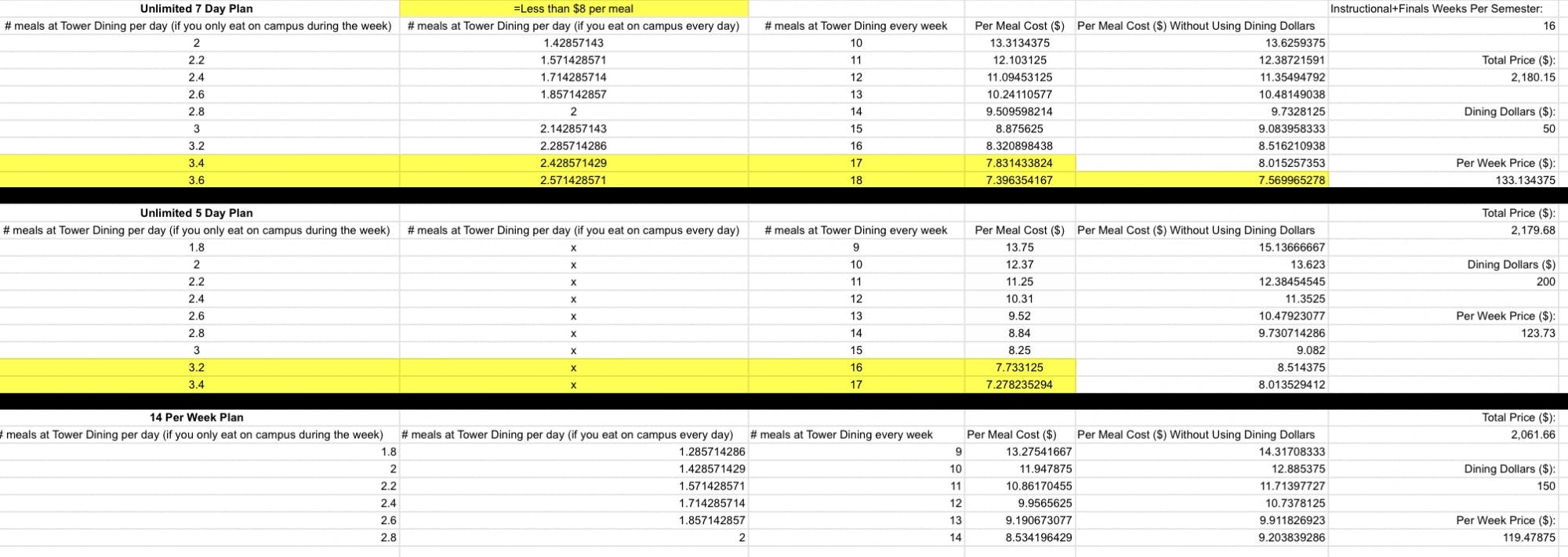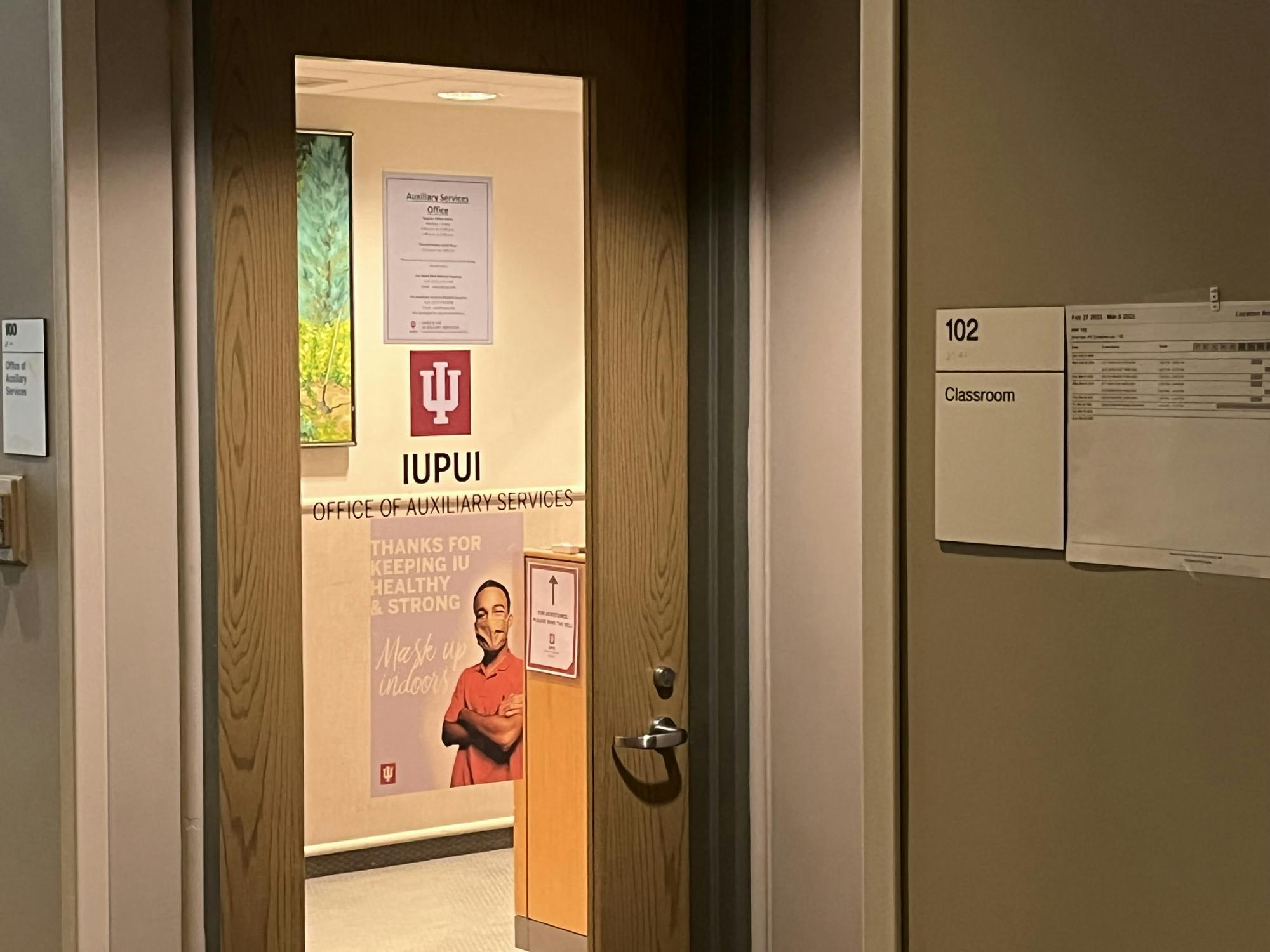Last November I moved off campus, breaking out of my housing and meal plan contract. The last thing I thought I would miss was Tower Dining, but on an impulse I decided to eat there again when an MD/PhD student canceled lunch with me. I was shocked when the entrance fee was only $8, including taxes. I considered that cheap for a buffet, having a big appetite and a tight grip on my wallet.
Something didn’t seem right, so I did the math. Most students with a required meal plan (i.e. those that live in Ball Hall, North Hall, or University Tower) have the Unlimited 7 Day Plan, which cost $2,180.15 last fall. There are 15 instructional weeks plus finals week every semester. Therefore, you would have to eat about 2.5 times every day of the week at Tower Dining for it to cost less than $8 per meal. That’s about 17 times per week, and the price is even worse if you don’t spend your dining dollars. If you want to check my math, see this spreadsheet.

But let’s just say you are like most students and don’t stay here on the weekends (or even Fridays). That’s 81 days. In that case you would have to eat about 3.4 meals every weekday for the price to be less than $8 per meal.
Unless you are like me and prefer to drown your sorrows in soft serve during finals week, it's unlikely that you will ever visit Tower Dining that much.
Moreover, many students prefer to eat a smaller breakfast or none at all, and eat food that they can prepare in their dorms on their own time schedule. If you don’t stay here on weekends, and only eat 2 meals per day, the per meal price for the Unlimited plan comes out to be about $13 per meal. At this price, many students sacrifice their monetary freedom, yet pay $5.00 more per meal than a stranger that walks into Tower Dining to write a newspaper article!

That’s why I asked Angie Hill, senior director of IUPUI Auxiliary Services, for an interview. The knowledgeable woman clearly knew a lot about food service management, and I barely had to ask any questions before she told me all I needed to know.
It seemed to me that most students weren’t getting their money’s worth. While many would certainly save about a hundred dollars outright by choosing the 14 per week plan (at about $9.10 per meal) or gain a little flexibility with dining dollars with the 5 Day Unlimited Plan, these options come with little benefit. Mrs. Hill admitted Auxiliary Services was working on improving these alternatives, particularly the Five Day Unlimited Plan.
She appreciated that I wanted to take a closer look at the prices behind meal plans, and encouraged students to make the most out of their meal plans by eating as much as they could at Tower Dining. Of course, she explained, equipment costs have to be factored into prices, and staffing continues to be a struggle during the post-COVID-19 era. Rent is also a factor, as IUPUI built the Campus Center with money from a loan. As such, Chartwells and Auxiliary services have to give “rent” to IUPUI on behalf of the Barnes and Noble bookstore and on-campus dining establishments to pay for that bond plus interest.

She also shared with me a number of things Auxiliary Services, Chartwells and the Office of Sustainability are doing to improve the experience, variety and quality in Tower Dining.
I learned that Adaptive Educational Services works with students with extreme allergies to have the cooks prepare special meals for them. I also learned a little bit about Paws Pantry, as well as the meal swipe donation program that began this year, which has provided 380 food vouchers for students in financial emergencies and they hope to continue next year.
I was also happy to hear they were working on providing more basic, customizable options for food. And, at the very least, for those worried about the quality of the chicken, Tower Dining has used pre-cooked chicken for the past four years to ensure that no one gets anything raw. She understood that food is very personal, so a bad experience at Tower Dining carried a lot of weight.
The most enlightening part of our interview occurred when I showed Mrs. Hill the math I had done to work out the per meal price for those purchasing a required meal plan. I explained how it was highly unlikely that many students ate enough to make their per meal cost less than $8, the per meal cost for someone like me without a meal plan.
She was perplexed. Apparently they had done a budget audit to determine the most appropriate base price for a meal based on costs, which had been set at around $9.40 per meal. No wonder the prices didn’t add up! Hundreds of students including myself without a meal plan likely reaped the benefit of much lower prices than anticipated, prices lower than for those students purchasing a required meal plan.
Evidently they did not successfully implement the new cost into the system.
So I recommend getting your $8 meals while they last. That was the first thing I did after leaving my interview with Mrs. Hill!
While this analysis is good, the problem of the cost of meal plans still begs for a solution.
The easiest would be to expand the options for required meal plans for those who eat less, and add more basic choices and flexibility with dining dollars. While Tower Dining is a great option, it is difficult to force students to eat at a single place which can’t possibly cater to the needs and preferences of everyone. Oftentimes it is just more convenient and a better experience for students to eat in their dorms on their own time schedule.
The reasoning behind forcing students to purchase a meal plan is to ensure they have access to a high quality breakfast, lunch, and dinner, since Ball Hall, University Tower, and North Hall lack kitchens within which to prepare meals. To solve this issue, perhaps IUPUI could build a teaching kitchen, similar to the one at our sister campus, IUB. This could be a dining hall without cooks, within which students are able to purchase their own supplies and prepare their own meals with the oversight of a few student interns or staff members. This could greatly decrease overhead operational costs, and could also provide a teaching environment for the various food-related programs at IUPUI.
I admit I have high expectations for a low-cost meal plan, especially coming out of high school during the 2021-2022 school year, where school lunches were free. That would certainly be difficult to achieve, since K-12 school lunches are government-subsidized, while college lunches are not. This is unfortunate, as it is highly likely that, at the very least, a “free or reduced price lunch” program at the college level would greatly aid low-income college students.
If the federal and state governments were to focus more on investing in the next generation, every dollar would go a long way to increase equity and social mobility in the United States. To make that happen, we need to vote in the primaries as well as the general election. To do so, register here, and go to the Indianapolis City-County Building to cast your ballot on these dates.
In the meantime, I look forward to seeing how Auxiliary Services and Chartwells improve student dining in the years to come.
Want to help The Campus Citizen see how often students really eat at Tower Dining? Fill out this survey. Otherwise, what are your thoughts? Do you have any ideas to reduce the cost of on-campus dining or to reduce the burden of college debt? Feel free to share them in the comments or by emailing me at stewar1@iu.edu, and submit feedback about Tower Dining here.
Update: Tower Dining recently corrected their per meal price to $9.47, bringing it into line with their costs determined at the beginning of the year while maintaining profitability.
Jacob Stewart (he/him) has been writing for the Campus Citizen since October of 2021. He likes to run and play the piano, but not at the same time. Particularly when he’s not writing or studying complex neurodevelopmental phenomena. He also likes using big words.





